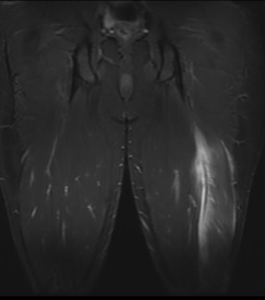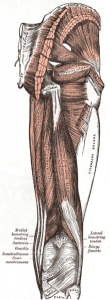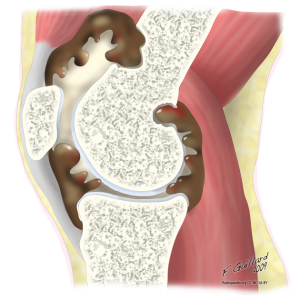Many sports physiotherapists rehabilitate hamstring injuries on a daily basis. Unfortunately, they can be very tricky to fully and definitively rehabilitate fully and reported re-injury rates are as high as 50%. This statistic inevitably leads to the people screaming it is due to inadequate rehabilitation techniques, which may be correct. Accordingly, this article will discuss new research which compares the clinical and morphological effects of 2 effective rehabilitation programs for hamstring injuries.
Those in the world of sports physiotherapy would be aware of the frequency with which we encounter episodes of patellar instability. Whilst much research is performed in the adult population, it is important to recognise patellar dislocation as one of the most common acute knee injuries in children. Accordingly, this article will discuss new research into the predictors of patellofemoral joint instability in the adolescent and paediatric populations.
Introduction Hamstring strains are commonly assessed and treated in the world of sports physiotherapy. They represent the most common injury in a number of sports, including AFL and soccer, accounting for up to 12-16% of injuries (Hawkins et al., 2001; Warren et al., 2010). Dvorak and Astrid (2000) suggested that hamstring injuries occur at an […]
How regularly do you treat injured athletes with reduced lower limb flexibility? The answer from many of you would likely be all day long! It has been well established that athletes with reduced lower limb flexibility are at greater risk of injury (Murphy et al., 2003). Thus, it would be logical that a program of regular stretching, which has been shown to improve lower limb flexibility (Harvey et al., 2002), would reduce this injury risk… wouldn’t it? Well, not conclusively…
It is no secret that sports physiotherapists and physical therapists across the world commonly assess and treat knee injuries. Of these injuries, patellofemoral pain is exceptionally common, accounting for 25% of all sports related knee injuries (Fredericson & Yoon, 2006). In fact, patellofemoral pain syndrome is the most commonly reported injury sustained by runners (Taunton et al., 2002). As many of the aetiological factors that contribute to patellofemoral pain syndrome have not been clearly identified, decision making regarding appropriate rehabilitation and treatment can often be challenging. This article will discuss the use of isometric adduction during closed kinetic chain lower limb exercises to facilitate vastus medialis obliquus (VMO) activation.
The post-operative rehabilitation of an ACL reconstruction is something that many sports physiotherapists perform on a daily basis. Many will know that muscular atrophy is quite common; particularly affecting the quadriceps, hamstrings and triceps surae. In fact, quadriceps atrophy and strength will often exceed 20% during the first three months (Nicholas et al., 2001). Therefore, we see post-operative rehabilitation protocols focusing on quick restoration of the patients muscle function and strength. Thus, we are often quick to, and appropriately so, prescribe exercises. However, this article will discuss the potential for the additional clinical benefits of electrical muscle stimulation (electro-stimulation)
Any physiotherapist working with academy footballers will know that these players are at risk of overuse injuries due to their immature musculoskeletal systems (1). However, it is imperative that therapists can confidently identify when the players require a therapeutic intervention rather than dismissing their symptoms as ‘growing pains’. It has been found that 5% of all injuries in football academies are due to overuse (1), as some young footballers will partake in high volumes of physical activity. This article will discuss the evidence based management of Osgood-Schlatters condition.
Patellofemoral pain syndrome is a condition that is commonly encountered by the sports physiotherapist. There is a clear reason for this, it has been reported to affect approximately 25% of athletes (DeHaven & Lintner, 1986). Furthermore, it is the most commonly reported injury sustained by runners (Taunton et al., 2002). Thus, it is the subject of much discussion on this site, and we have provided articles on a number of management options for patellofemoral pain syndrome. However, this article will discuss new research on potential prospective indicators for the development of patellofemoral pain syndrome.
We all know that hamstring strains are common injuries within sports that involve sprinting and jumping. In fact, they represent a significant proportion of muscle injuries: 50% in sprinting, 40% in soccer (Yeung et al, 2009) and 14% in Australian Rules football (Gabbe et al, 2006). They have been shown to be more common than any other muscle injuries and players are 2.5 times more likely to suffer a hamstring strain compared to a strain of their quadriceps (Woods et al, 2004). This is significant as Small et al (2010) found that soccer players miss on average 3 competitive matches per hamstring injury. Consider the huge impact on the success of sporting teams when high profile players are injured!
Now, I’m not hear to scare you. But there are many conditions out there that are so uncommon that we often don’t even know that they exist. Unfortunately, sometimes these conditions may walk into our clinics and have us shaking our heads in disbelief and asking ourselves… ‘why don’t you fit into that diagnosis!’. I think for many pigmented villonodular synovitis (PVNS) of the knee is one of these diagnoses. It is quite rare, however, it presents similarly to many of the conditions that we as sports physiotherapists treat on a daily basis. This article discusses PVNS including assessment, diagnosis, and the treatment options.
In the past this site has featured some lighter, colloquial blog posts. These articles discuss issues related to the greater physiotherapy community. Thus, I present a few mantras I have heard, adapted or made up for the physios to live by in the coming year.
Radial tunnel syndrome is rare, it is challenging to differentially diagnose and can be a monster to manage. If you have a recalcitrant case of tennis elbow then this post will interest you! This article discusses the best available evidence for assessment and management of radial tunnel syndrome.







